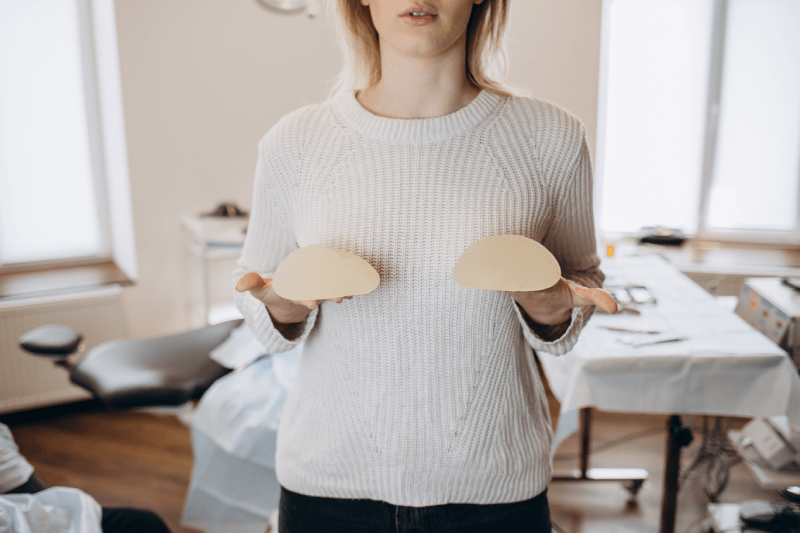Breast asymmetry is a condition seen in a significant number of women, where the two breasts are different in size, shape, or position. This condition, beyond being a physical issue, can negatively affect individuals’ self-confidence and psychological state. This comprehensive guide provides enlightening information by addressing all aspects of breast asymmetry, from its causes to treatment methods, the surgical process to the recovery period. Our content also includes guiding information for those considering this operation, especially in Turkey.
What is Breast Asymmetry Correction Surgery?
Breast asymmetry correction surgery is a surgical procedure aimed at making both breasts more harmonious in size, shape, and position. This operation usually involves augmenting one breast, reducing the other, augmenting or reducing both, or using only breast lift techniques to correct the asymmetry. The goal of the surgery is not only to achieve an aesthetic appearance but also to provide psychological relief by improving the person’s body image. The surgeon carefully evaluates each patient’s unique situation to determine the most suitable method. This evaluation includes factors such as breast tissue density, skin elasticity, and overall body structure.
Causes of Breast Asymmetry
Breast asymmetry can have many different causes. One of the most common causes is the different rates of breast development during puberty. Genetic factors also play a significant role in asymmetry. The presence of asymmetry in family members may indicate a genetic predisposition. In addition, life events such as hormonal changes, trauma or injuries, pregnancy, and breastfeeding can also increase or trigger breast asymmetry. In rare cases, breast asymmetry can be a symptom of an underlying medical condition, such as a benign or malignant tumor. Therefore, it is of great importance to consult a specialist when a noticeable asymmetry is observed.
Types of Breast Asymmetry
Breast asymmetry can manifest in various ways and is generally divided into three main categories: size, shape, and positional asymmetry. In size asymmetry, one breast is noticeably larger or smaller than the other. This is the most common type of asymmetry. Shape asymmetry is when the contours and fullness of the breasts are different; for example, one breast may be more rounded while the other is more oval. Positional asymmetry is when the breasts, nipples, or areolas (the dark circle around the nipple) have different heights or positions on the chest wall. These types of asymmetry can appear alone or in combination.
Psychological and Social Effects of Breast Asymmetry
In addition to its effect on a person’s physical appearance, breast asymmetry can deeply affect their psychological and social life. Low self-esteem, body image concerns, and even depression are commonly seen psychological problems in individuals with asymmetry. This situation can lead to feelings of shame and embarrassment in social settings, especially at a young age. Clothing choices can become difficult, and people may prefer certain outfits to hide the asymmetry. This psychological burden can seriously lower an individual’s quality of life, and therefore, breast asymmetry correction surgery should be seen not just as an aesthetic procedure, but as a treatment method that also aims for psychological healing.
Non-Surgical Treatments for Breast Asymmetry
Some non-surgical methods are also available to correct breast asymmetry, but these methods generally offer an alternative when the degree of asymmetry is mild or for those who do not want to undergo surgery. Specially designed bras or lingerie can help to hide the size difference between the breasts. Silicone or gel-filled bras can add fullness to the smaller breast. Exercise can strengthen the chest muscles, making the breasts look fuller and firmer, but this does not completely correct the asymmetry. These non-surgical methods do not offer a permanent solution and do not eliminate the root cause of the asymmetry. Therefore, in cases of severe asymmetry, surgical intervention often becomes inevitable.
Candidates for Breast Asymmetry Correction Surgery
The most suitable candidates for breast asymmetry correction surgery are individuals who are physically and psychologically healthy. Candidates must be over 18 years old and have completed breast development. It is also important to have realistic expectations for the surgery. The goal of the surgery is to make the breasts more harmonious rather than to achieve perfect symmetry. The risks of surgery may be higher for smokers or those with certain chronic diseases. Therefore, the surgeon performs a comprehensive examination to evaluate the patient’s general health and suitability for surgery. Candidates are expected to fully understand the potential risks and benefits of the surgery and make this decision consciously.
Pre-operative Evaluation and Planning
The success of breast asymmetry correction surgery depends on detailed pre-operative planning. In the initial consultation, the surgeon learns about the patient’s medical history, the cause of breast asymmetry, and their expectations. During the physical examination, the size, shape, position, and skin quality of both breasts are carefully examined. As a result of this evaluation, the surgeon decides which method or combination of methods will yield the best result. The patient is provided with detailed information about how the surgery will be performed, the techniques to be used, and the expected outcomes. Photographs are taken to estimate the post-operative results, and all details are openly shared with the patient.
Surgical Methods: Reduction and Augmentation
Surgical methods used to correct breast asymmetry are usually a combination of augmentation and reduction techniques. If one breast is much smaller than the other, the size difference is corrected with breast augmentation surgery using silicone implants or fat grafting. On the other hand, if one breast is much larger than the other, the size imbalance is corrected with breast reduction surgery by removing excess breast tissue, fat, and skin. Sometimes, both breasts may require intervention; one breast may be augmented, and the other may be reduced. These two main methods are planned together to achieve the most effective results depending on the degree and type of asymmetry.
Techniques Used in Surgery
The techniques used in breast asymmetry correction surgery vary depending on the patient’s anatomy and the type of asymmetry. If the asymmetry is caused only by a difference in breast size, breast implants or fat grafting may be sufficient. If one of the breasts is sagging or the nipple position is different, breast lift (mastopexy) techniques are also included in the surgery. The incision techniques applied for breast lift can be an inverted T, lollipop, or periareolar (around the nipple) incisions. The surgeon chooses the technique that will leave the least amount of scarring and provide the best result. These techniques are often combined to achieve the most symmetrical and aesthetic result.
Correction with Breast Implants
Breast implants are one of the most common methods for correcting breast asymmetry. This method is especially preferred in cases where one breast is noticeably smaller than the other. The surgeon places an implant in the smaller breast that is suitable for the size and shape of the other breast, thus providing symmetry. Implant selection depends on many factors such as volume, shape (teardrop or round), surface texture (textured or smooth), and gel type (firm or soft). The surgeon determines the most suitable implant in line with the patient’s body structure and expectations. Implants can be placed through incisions made under the breast, around the nipple, or in the armpit.
Correction with Fat Grafting
Fat grafting is another natural method used in the correction of breast asymmetry. In this technique, fat taken from another area of the body (usually the abdomen, hips, or thighs) is processed and purified, and then injected into the smaller breast. Fat grafting is an ideal solution in cases where the asymmetry difference is not very large. Since some of the injected fat may be absorbed over time, more than one session may be required to achieve the desired result. Fat grafting is a good alternative for patients who do not want breast implants or have a very small volume difference, and it does not leave a surgical scar.

Correction with Breast Lift (Mastopexy)
Breast asymmetry can be caused not only by a size difference but also by the sagging of one or both breasts. In this case, breast lift surgery (mastopexy) comes into play. Mastopexy reshapes the sagging breast by removing excess skin and repositioning the breast tissue, giving it a firmer and more youthful appearance. This method is used in combination with augmentation or reduction surgery, especially when asymmetry is accompanied by sagging. The surgeon also corrects the position of the nipple, eliminating the height difference between the breasts. Mastopexy does not add volume to the breast; it only corrects the shape and position.
Combined Methods
To successfully correct breast asymmetry, it may often be necessary to use more than one surgical method together. For example, if the volume and position of one breast are different from the other, both breast augmentation and lift (mastopexy) surgery can be performed simultaneously to correct this condition. If one breast is too large and sagging, breast reduction and lift operations can be combined. These combined methods allow the surgeon to address all aspects of the asymmetry and create a personalized plan that will provide the best result for the patient. Since each patient’s asymmetry is unique, the treatment plan should also be tailored to the individual.
Performing the Surgery
Breast asymmetry correction surgery is usually performed in a hospital setting under general anesthesia. The duration of the surgery varies depending on the techniques applied and the degree of asymmetry, but it takes an average of 2 to 4 hours. The surgeon performs the operation by adhering to the pre-operative plan and making the determined incisions. If a breast implant is to be placed, this procedure is completed. If breast reduction or lifting is to be performed, excess tissue and skin are removed, and the breasts are reshaped. At the end of the surgery, the incisions are closed with aesthetic sutures, and the operation is completed.
Surgery Duration and Anesthesia
Breast asymmetry correction surgery has a duration that varies according to the complexity of the asymmetry and the methods to be applied. The surgery may take less time if a minimal correction is to be made on a single breast, while the duration will be longer if a comprehensive procedure is to be performed on both breasts. This operation, which is generally completed in 2 to 4 hours, is mostly performed under general anesthesia. General anesthesia ensures that the patient is completely asleep and feels no pain during the surgery. The anesthesiologist evaluates the patient’s general health condition before the surgery and prepares the safest anesthesia plan.
Post-operative Recovery Process
The post-operative recovery process can vary from patient to patient, but the first few days are generally the most sensitive period. Patients are usually discharged on the same day or the day after the surgery, after being kept under observation for a few hours. Pain and swelling are normal for the first few days and can be controlled with prescribed painkillers. Patients are advised to wear a special support bra after the surgery. Light activities can be resumed within the first week, but heavy sports and lifting should be avoided. Full recovery usually occurs within a few weeks.
Post-operative Care and Precautions
To ensure a successful recovery after breast asymmetry correction surgery, it is very important to fully follow the surgeon’s instructions. Keeping the surgical area clean and dry reduces the risk of infection. Regular use of prescribed medications helps to control pain and swelling. Heavy exercise and physical activities should be avoided for a few weeks after the surgery. Smoking and alcohol consumption should be stopped during this period, as they can negatively affect the healing process. Regular check-ups and using the support bra as recommended by the surgeon improve the quality of the final result.
Possible Risks and Complications
As with any surgical procedure, breast asymmetry correction surgery has some risks and complications. The most common risks include infection, bleeding, wound healing problems, the inability to completely correct the asymmetry, and if an implant is placed, implant displacement or capsular contracture (the formation of a hard capsule around the implant). In rare cases, there are also risks associated with anesthesia. Choosing an experienced surgeon and adhering to post-operative instructions helps to minimize these risks. It is important that the patient is informed in detail about all risks before the surgery.
Breast Asymmetry Correction Surgery in Turkey
Turkey has become a popular destination for breast asymmetry correction surgery among both domestic and international patients. The main reasons for this include modern hospitals and clinics with advanced technology, highly qualified and experienced plastic surgeons, and more affordable costs compared to other countries. Turkey is known for the quality of its services, especially in the field of health tourism. Many clinics offer comprehensive packages for international patients, including accommodation, transfers, and interpreter services.
Choosing a Doctor and Clinics in Turkey
For those considering breast asymmetry correction surgery in Turkey, choosing the right surgeon and clinic is of critical importance. It is important to check whether the surgeon is a member of the Turkish Society of Plastic, Reconstructive and Aesthetic Surgeons (TPRECD), to get information about their experience, and to read previous patient reviews. The hygiene standards, technological infrastructure, and patient safety policies of the clinic or hospital where the surgeon works should also be taken into consideration. Most surgeons offer free or low-cost consultations before the surgery.
Cost of Surgery and Insurance Coverage
The cost of breast asymmetry correction surgery varies greatly depending on the degree of asymmetry, the techniques to be used (implants, fat grafting, etc.), the clinic where the surgery will be performed, and the surgeon’s experience. In most cases, breast asymmetry correction surgery is considered an aesthetic procedure, so it is not covered by private health insurance. However, if the asymmetry is very severe and can be medically proven to cause physical or psychological problems, insurance companies may make a partial payment. Therefore, it is useful to contact the insurance company before the surgery.
Post-operative Satisfaction and Lasting Results
The results of breast asymmetry correction surgery are generally very gratifying. The vast majority of patients are very satisfied with the more symmetrical and aesthetic appearance they achieve after the operation. The results vary depending on the type of operation. Corrections made with breast implants are permanent, but some of the injected fat in fat grafting may be absorbed over time. The results of breast lift surgeries may change over time with gravity and the aging process, but the shape and symmetry achieved are largely maintained.
Breast Asymmetry Correction Surgery and Pregnancy
Breast asymmetry correction surgery generally does not affect future pregnancy and breastfeeding ability. In breast reduction surgeries, nipple sensation and milk ducts may be affected, but this does not always lead to breastfeeding problems. Breast augmentation surgery, as it usually involves minimal intervention in the breast tissue, rarely affects the ability to breastfeed. It is important for individuals who plan a pregnancy after the surgery to discuss this in detail with their surgeon and determine the timing of the surgery accordingly.
Recurrence of Asymmetry and Revision Surgeries
After breast asymmetry correction surgery, asymmetry may recur in rare cases. This may be due to factors such as weight changes, aging, pregnancy, or hormonal fluctuations. In patients with implants, the position of the implant may change over time or capsular contracture may occur. In such cases, revision surgery may be required to correct the asymmetry. Revision surgeries can be more complex than the initial operation and require additional experience from the surgeon.
Frequently Asked Questions
- Is the surgery painful? Post-operative pain can be easily controlled with painkillers.
- Are the scars permanent? Scars remain from all surgical procedures, but surgeons try to make incisions in the least visible areas. The scars fade over time and become less noticeable.
- When can I return to work after the surgery? Those who work in an office job can usually return to work within a week. For more physically demanding jobs, this period may extend to 2-3 weeks.
- Is breast asymmetry an aesthetic problem? Breast asymmetry, in addition to being an aesthetic concern, is an important condition that also affects an individual’s psychological health.
- What are the advantages of having surgery in Turkey? Turkey is advantageous because it offers quality healthcare services, experienced surgeons, and affordable costs.
Important Note: This article is for general informational purposes only. You must consult a competent plastic surgeon before making a surgical decision. There are many successful surgeons working in this field in Turkey. The most appropriate approach is to evaluate your personal situation with a specialist to make a healthy and informed decision.

